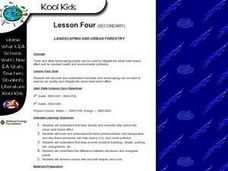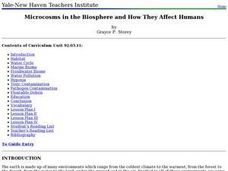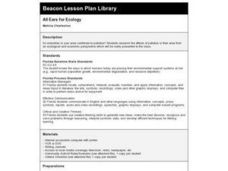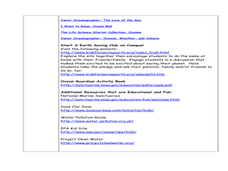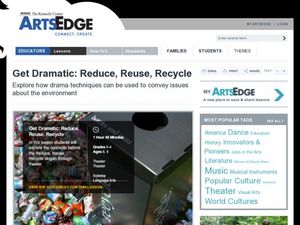Curated OER
Recycle
Students determine the weight of paper waste generated by the class. They brainstorm ways to reduce and recycle. They make their own paper to demonstrate recycling. This lesson is very effective in demonstrating how recycling works.
Curated OER
Erosion in Freshwater Ecosystems
Young scholars explore the concept of sediment pollution. In this erosion lesson, students discuss the process of erosion and determine how sediment pollution affects animals that live in freshwater ecosystems. Young scholars respond to...
Curated OER
Birds, Baths And Oil Spills
Students examine effects of an oil spill on birds and animals that inhabit marine or freshwater ecosystems, and simulate procedures used by rescue workers who rescue and rehabilitate birds and other animals coated with oil.
Curated OER
Evaporation and Condensation
Students explore how temperature affects the processes of evaporation and condensation.
Curated OER
Waterwheel Work
Young scholars investigate the history of the waterwheel and common uses for water turbines today. They construct an experimental waterwheel using a two-liter plastic bottle, measure the rate of revolution of a waterwheel, and complete...
Curated OER
Landscaping and Urban Forestry - Lesson 4 (Grades 5-6)
Students discuss reasons to plant trees and the best locations for cooling. They analyze two homes identifying types and locations of trees, and location of the central air conditioners. The benefits of shade, the process of...
Curated OER
Landscaping And Urban Forestry - Lesson 4 (Grades 8-9)
Students discuss reasons to plant trees and the best locations for cooling. They study two homes and identify types and locations of trees and determine the placement of the central air conditioners. The class plans a landscape design...
Curated OER
The Solution to Pollution is Dilution
Students consider what happens to herbicides or insecticides that are used in agricultural practices, especially herbicides that are used to control noxious weeds. They become acquaint with a chemical assessment method known as...
Curated OER
Science: Microcosms in the Biosphere
In a series of lessons, examine the impact on humans by microcosms in the biosphere. Among the plans structured for learners with different abilities and learning styles, are activities describing the symbiotic relationship, drawing the...
Curated OER
All Ears for Ecology
Fourth graders research to see the effects that air pollution has on where they live. They explore improper dumping of waste run-off, air pollution, and water pollution.
Curated OER
TIES MSEE Sensor Lesson Plan
Students explain how a sensor works. In this technology lesson, students determine the air quality around their school. They record observations and share results to class.
Curated OER
What is a Watershed?
Students create a classroom size model of a landscape to define the concept of a river watersheds. They spread crumbled newspapers around the floor to simulate different elevations then cover the whole landscape with a sheet. They pour...
Curated OER
Eye On Conservation Drainage Basin
Middle schoolers are able to describe the importance of wetland vegetation. They describe the impacts human activities have on water systems. Students compare and contrast the effect of different soil types on water filtration.
Curated OER
Out & About: Waterways
Students visit science museums. For this hands-on science lesson, students visit the Leith Conservation Trust, Catalyst, and the River and Rowing Museum in person or online to study Britain's waterways.
Curated OER
Acid Rain
Students perform experiments to determine how different acids cause acid rain. They measure the pH of the water to calculate the water's acidity. They discover how acid rain dissolves rock materials.
Curated OER
100 Things You Can Do to Save the Planet
Students examine the possible ways to recycle, reuse, and re-imagine products and objects in order to reduce pollution and waste on our planet. In this 100 things you can do to save the planet lesson, students take three actions to...
Curated OER
Clouds
Students recognize the three main types of clouds. In this clouds lesson, students create a cloud mobile to understand clouds.
Curated OER
I Can Preserve My Planet
Students explore renewable and nonrenewable resources. In this ocean preservation lesson, students use KWL charts to understand ways the ocean is important to our daily lives. Students create a poster or wirte a letter to someone...
Michigan Sea Grant
Wetlands
Wetlands may not sound particularly ornate, but they are as important as any habitat! With a hands-on activity, young scientists build a wetland model and observe its many functions in action. They discover the importance of wetlands to...
Curated OER
Get Dramatic: Reduce, Reuse, Recycle
Students explain reducing, recycling and reusing. In this science/ arts instructional activity, students create a commercial and display a backdrop made out of recycled goods. Additionally, students write written responses to writing...
Curated OER
Getting Thirsty?
Young scholars explore the concept of drought and its significance as a natural hazard. For this drought lesson plan, students complete 13 questions on an "Introduction to Drought as an Ecosystem Stressor" worksheet and discuss the...
Curated OER
Quilt Squared
Students study West Virginia quilts. In this mathematics lesson, students use symmetry, geometric shapes, and patterns to create their own quilt square.
Curated OER
In the Company of Whales
Students examine whales and how they migrate. In this whale lesson students research whales and their migration patterns.
Curated OER
Break the Tension
Learners experiment with the concepts of surface tension. They participate in a number of different experiments that introduce them to surface tension. They work in a small group in order to conduct these experiments.








